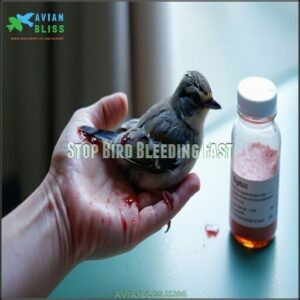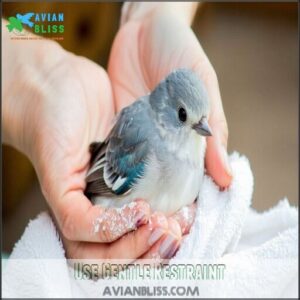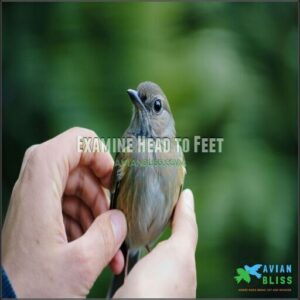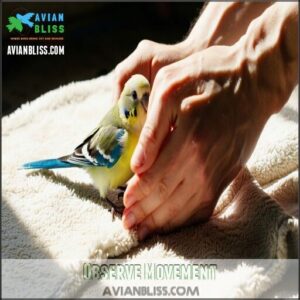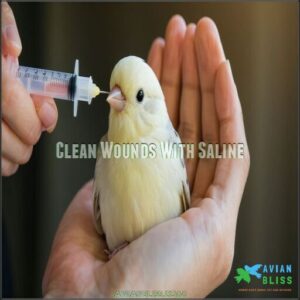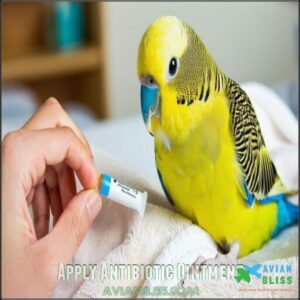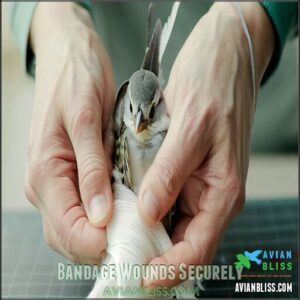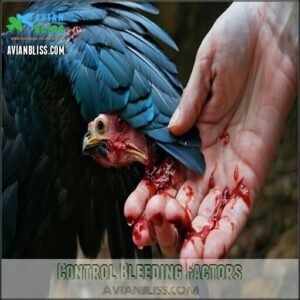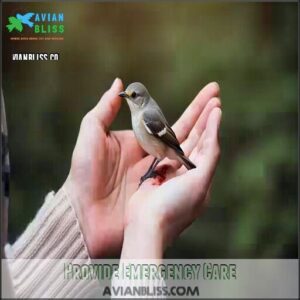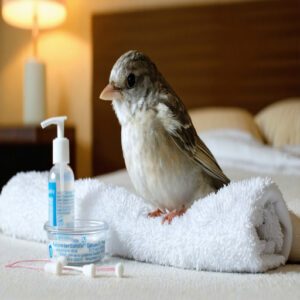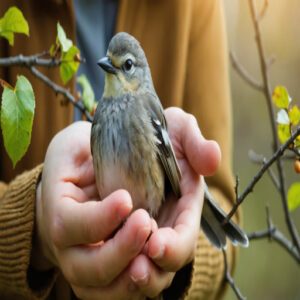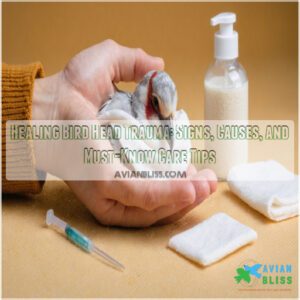This site is supported by our readers. We may earn a commission, at no cost to you, if you purchase through links.
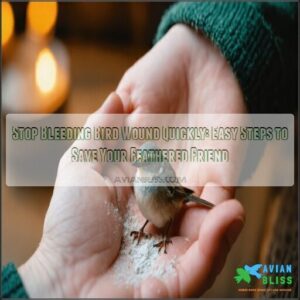
Apply styptic powder (or cornstarch in a pinch) directly to the wound and press gently with a clean cloth for 1-2 minutes.
For nail or beak injuries, dip the area directly into the powder.
Keep your bird warm and quiet during this process, as stress can increase bleeding.
Once bleeding stops, observe for at least an hour to confirm it doesn’t resume.
Clean the wound gently with diluted antiseptic solution only after bleeding has completely stopped.
Proper wound care techniques can mean the difference between recovery and complications, and it’s crucial to follow these steps to ensure your bird receives the best chance at a full recovery.
Table Of Contents
- Key Takeaways
- Stop Bird Bleeding Fast
- Check for Injuries
- Treat Bird Wounds
- Control Bleeding Factors
- Provide Emergency Care
- Frequently Asked Questions (FAQs)
- What can you use to stop bleeding on a bird?
- Can I use flour to stop bird bleeding?
- What can I put on a bird’s open wound?
- What to do if a bird is injured and bleeding?
- Can human medications stop bird bleeding?
- How do feather dust and preening affect clotting?
- Does bird age impact bleeding duration?
- Can diet supplements improve blood clotting?
- Will cold weather worsen bleeding in birds?
- Conclusion
Key Takeaways
- Apply styptic powder (or cornstarch in a pinch) directly to the wound and apply gentle pressure with a clean cloth for 1-2 minutes to quickly stop bleeding.
- Keep your bird warm and in a calm environment during treatment, as stress can increase bleeding and worsen their condition.
- Clean the wound with saline solution only after bleeding has completely stopped, then apply a bird-safe antibiotic ointment to prevent infection.
- Seek veterinary care immediately if bleeding doesn’t stop within 5 minutes, if you notice signs of shock (fluffed feathers, lethargy, cold limbs), or for serious injuries like deep cuts or internal bleeding.
Stop Bird Bleeding Fast
Stopping a bird’s bleeding quickly is essential since they’ve a small blood volume and can lose too much blood fast.
With simple steps like applying styptic powder or gentle pressure, you can help your feathered friend stay safe and start healing.
Apply Styptic Powder
Styptic powder is a simple, effective bird bleeding remedy for minor wounds.
Gently apply it with a cotton swab directly to the bleeding area to promote clotting. Use only a small amount—safe dosage matters!
It’s perfect for quick bird first aid, helping prevent re-bleeding.
Various options exist for avian care. Monitor recovery closely, and if needed, explore powder alternatives like cornstarch for bird bleeding control, considering minor wounds and the need for quick bird first aid.
Use Hemostatic Forceps
When styptic powder isn’t enough, hemostatic forceps can stop bird bleeding fast.
These small tools clamp bleeding vessels with ease, offering precise bird bleeding control. Verify proper grip and choose a forceps size that suits your bird.
Knowing essential supplies is vital for effective first aid.
- Sterilize forceps before use for safety.
- Gently clamp the bleeding site.
- Avoid crushing feathers unnecessarily.
- Clean thoroughly after use.
The proper use of these tools requires attention to safety and careful handling to ensure the well-being of the bird.
Apply Gentle Pressure
After using styptic powder or forceps, gently press a clean cloth material against the bleeding wound.
Focus on pressure points to stop bird bleeding effectively. Hold steady for a few minutes, monitoring clotting and bleeding duration carefully.
This simple bleeding bird remedy is key for bird wound care and helps the bleeding slows. Calm handling helps your feathered friend feel secure.
Check for Injuries
Before you can treat your bird, it’s important to check for other injuries that may not be obvious.
Stay calm, work gently, and watch for signs like swelling, bruises, or abnormal movement.
Create Calm Environment
Set the scene to reduce stress for the bleeding bird.
Dim lighting to create a calm environment, and minimize loud noises.
A quiet space helps soothe their nerves.
Follow these steps:
- Gently place the bird in a towel-lined, secure space.
- Keep movements slow and careful to avoid startling.
- Speak softly to maintain a relaxed atmosphere.
Use Gentle Restraint
Use a towel restraint to keep the bird in a comfortable position, minimizing stress and avoiding injury.
Hold securely but gently—think firm, not forceful.
Secure handling guarantees they don’t squirm while you apply first aid, like cornstarch to stop bleeding.
A calm bird lets you address minor wounds safely, giving you a better chance at quick bleeding control with the use of materials like cornstarch.
Examine Head to Feet
Start by gently inspecting from head to feet, focusing on head trauma, feather condition, and swelling detection.
Check wings for wounds and the body for swelling or bird wound bleeding control.
Examine each leg for leg deformities, ensuring no visible injuries. Don’t overlook the feet, as neglected injuries there often worsen quickly.
Stay calm to provide effective bird first aid during emergencies, ensuring you can handle situations involving swelling detection.
Observe Movement
Watching your bird’s movement reveals much about its health.
Look for gait abnormalities, like limping or dragging a leg, and pay attention to flight patterns.
A mobility assessment can highlight balance issues or poor wing function.
Subtle changes might seem minor but could mean more serious problems.
Movement checks are a key step in bird emergency care and bleeding control.
Treat Bird Wounds
Cleaning and protecting your bird’s wound is essential to help it heal and prevent infections.
With a little care and the right steps, you’ll help your feathered friend feel better in no time.
Clean Wounds With Saline
After checking for injuries, cleaning the wound comes next. Saline solution is safe and prevents infection while promoting healing.
Use a cotton ball or syringe to gently flush debris away. For alternatives, boiled, cooled water works in a pinch.
Keep your bird comfy and steady—no one likes wound care, but it’s first aid gold!
- Flush gently, avoid scrubbing.
- Use sterile saline or clean water.
- Remove dirt or contaminants carefully.
- Stay calm, act confidently.
Apply Antibiotic Ointment
Gently dab a small amount of antibiotic ointment on the cleaned wound, avoiding over-application, as birds’ skin is delicate.
This Ointment Application Technique helps with Infection Prevention, reducing the risk of complications.
Always use bird-safe products for effective bird wound care. Povidone iodine is a recommended antiseptic solution.
After wound cleaning, monitor healing closely to confirm proper recovery as part of your bird wound treatment.
Bandage Wounds Securely
For effective bird wound care, choose bandage materials like nonstick or porous fabric to allow healing.
Use a precise wrapping technique to provide secure fastening without restricting movement. Protect the wound by ensuring proper tension, and monitor circulation to avoid issues.
A suitable bandage is essential for recovery. Bird wound bleeding prevention relies on snug bandaging done right—this first aid step makes all the difference, and is a critical part of the healing process.
Control Bleeding Factors
In the context of controlling bleeding in birds, understanding what affects it’s key.
Factors like the wound’s severity, its location, and your bird’s overall health all play a role in stopping the blood quickly and safely, which is a key aspect to consider.
Severity of Injury
Not all bird injuries are the same.
Minor scratches may stop bleeding quickly, but deep cuts, broken bones, or internal bleeding need immediate attention.
Serious wounds increase the infection risk and require urgent care.
Assess the injury severity carefully—if bleeding lasts over five minutes despite first aid, or symptoms worsen, it’s time to seek professional wound care.
Bird bites can also transmit blood-borne diseases, which poses a significant risk, making immediate attention crucial.
Location of Injury
Where bleeding happens on your bird matters.
Areas like the nares, eyes, mouth, or ears are rich with vessels, so expect fast blood flow.
To manage:
- Press gently with a clean cloth for toenail bleeding.
- Use styptic powder for mouth injuries or ear bleeding.
- Seek a vet for eye injuries, as severity may escalate quickly.
Bird’s Health Status
When your bird’s health is compromised, such as from stress, weakened immunity, or nutritional deficiencies, its natural clotting ability can suffer, making bleeding harder to control.
Pre-existing conditions also play a role in recovery.
During bird wound care, prioritize minimizing stress and consult an avian veterinarian quickly. Remember, good bird health is key to handling emergencies like this effectively, and it is crucial for effective recovery.
Type of Bleeding
After considering the bird’s health, understanding types of bleeding helps with control.
- Internal bleeding often shows as weakness or bloody droppings.
- External wounds may clot naturally but need monitoring.
- Orifice bleeding (eyes or nares) requires urgent care.
- Blood with clotting efficiency issues takes longer to stop.
- Heavy bleeding? Act fast—you’re saving precious life.
Provide Emergency Care
When your bird is injured, quick and calm action can make all the difference.
By recognizing signs of shock, keeping them warm, and transporting them safely, you’ll give your feathered friend the best chance for recovery.
Recognize Signs of Shock
Looking at the "Recognize Signs of Shock" section, I’ll create a concise, engaging blockquote that maintains the same tone:
A bird in shock has minutes, not hours. Watch for fluffed feathers, lethargy, and cold limbs—act fast!
Keep an eye out for bird shock. Lethargy signs like quietness or droopy posture, unresponsiveness, and fluffed feather condition signal trouble.
Breathing issues, cold body temperature, or worsening bleeding also mean the bird needs first aid ASAP.
A calm environment and prompt emergency care can save their life. Remember, quick action prevents serious complications in these fragile creatures.
Transport Injured Birds
When heading to the avian veterinarian, make certain your carrier size allows comfortable entry and movement.
Line it with a towel to cushion bumps, and check for adequate ventilation needs. A suitable carrier is essential, and you can find a proper bird transport.
Safe handling reduces stress and bleeding risks. Minimize movement with a secure carrier and a quiet environment.
Prompt emergency care improves chances for effective bird wound treatment and recovery.
Keep Bird Warm and Calm
A calm bird heals faster, so reducing stress is key.
Place your feathered friend in a ventilated carrier lined with a towel. Speak softly and minimize movement to create a quiet environment. Gentle handling guarantees they feel secure.
Small steps like these reduce bird stress while you manage their wound first aid. Remember to recognize early signs of illness for timely intervention.
- Use a towel-lined carrier
- Speak in low, calming tones
- Handle with steady, gentle hands
Seek Veterinary Care
If your bird’s bleeding won’t stop or you notice signs of shock, such as fluffed feathers or sluggish behavior, it’s time to contact an avian veterinarian.
Internal bleeding and animal bites often come with complex issues needing expert care. Avian vets handle what first aid can’t.
| Situation | Action Needed | Reason |
|---|---|---|
| Non-stop bleeding | Call an avian vet | Small blood loss can be life-threatening. |
| Animal bites | Seek veterinary care | High risk of infection. |
| Internal injuries | Visit avian veterinary | Requires scans or specialized treatment. |
The situations that require immediate attention include non-stop bleeding, animal bites, and internal injuries, all of which can be life-threatening if not treated promptly by an avian vet.
Frequently Asked Questions (FAQs)
What can you use to stop bleeding on a bird?
You can apply styptic powder directly to wounds, or use cornstarch as an alternative.
For broken blood feathers, remove them with hemostatic forceps.
Gentle pressure with a clean cloth helps until bleeding stops, which can be a critical step in stopping the bleeding.
Can I use flour to stop bird bleeding?
For Pete’s sake, you can use flour in a pinch.
It’ll help clot minor bird bleeding by absorbing blood and forming a scab.
Cornstarch or styptic powder works better for quicker results.
What can I put on a bird’s open wound?
First clean the wound with saline solution or diluted hydrogen peroxide.
Then apply antibiotic ointment approved for birds. Cover with a non-stick gauze if possible.
You’ll need veterinary care for serious injuries.
What to do if a bird is injured and bleeding?
When you discover a bleeding bird, act quickly!
Control bleeding with gentle pressure using a clean cloth.
Apply styptic powder or cornstarch to the wound.
Keep the bird warm and seek veterinary care immediately.
Can human medications stop bird bleeding?
No, don’t use human medications on bleeding birds.
They’re too potent and can be toxic.
Instead, use cornstarch, flour, or styptic powder specifically made for animals.
Always consult an avian vet afterward.
How do feather dust and preening affect clotting?
Feather dust contains natural proteins that can help blood coagulate, while preening distributes these proteins across the bird’s body.
When birds preen an injured area, they’re actually supporting the clotting process.
Does bird age impact bleeding duration?
Like leaves in autumn, a bird’s age does substantially impact bleeding time.
Young birds have more active circulation and may bleed longer, while elderly birds might experience delayed clotting due to weaker blood vessel integrity, which affects their bleeding time and overall health, with circulation playing a crucial role.
Can diet supplements improve blood clotting?
Certain vitamin K and calcium supplements can help improve your bird’s blood clotting abilities. You’ll want to consult your avian veterinarian before adding anything new to your feathered friend’s diet.
Will cold weather worsen bleeding in birds?
Just as winter freezes the flowing stream, cold weather can worsen bleeding in birds.
It chills their bodies, constricts blood vessels, and slows clotting.
You’ll need to warm your bird while treating wounds.
Conclusion
Remember, treating a bleeding bird wound quickly is like putting out a small fire—swift action prevents bigger problems.
By following these steps, you’ll be prepared to stop bleeding bird wounds quickly and effectively.
Always keep styptic powder, antiseptic solution, and clean cloths in your bird first-aid kit.
Your timely response can make all the difference in your feathered friend’s recovery.
When in doubt, don’t hesitate to contact an avian veterinarian for professional guidance.

